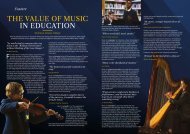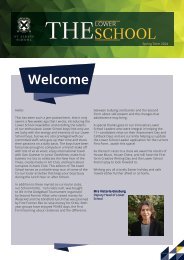You also want an ePaper? Increase the reach of your titles
YUMPU automatically turns print PDFs into web optimized ePapers that Google loves.
The Last Witch<br />
We all know the popular image of witches and<br />
witchcraft, dancing around the cauldron in a naked<br />
frenzy of devil worship: but what were they really<br />
like? If only voices from the likes of Jane Wenham<br />
could return from the past. If she could speak<br />
to us today, she might be able to speak with some<br />
authority; she was apparently the last person in<br />
England tried and found guilty of witchcraft. Hers<br />
is a voice I would listen to, charged as she was with<br />
turning in to a cat and conversing with the devil.<br />
I’m not sure, examining her more closely, that<br />
the stereotype of chanting in a group of thirteen<br />
whilst mocking the bible and drinking the blood of<br />
murdered infants really stands up to scrutiny any<br />
more now, than it may have done then. The main<br />
source for this essay is the narrative account of the<br />
trial written by Charles Jones in the 1930s whose<br />
purpose appears to point out the past’s peculiarities.<br />
Perhaps re-examining Wenham’s case with the lens<br />
of an historical anthropologist, we can truly shelve<br />
the witchcraft image with the other clichés where<br />
the truth goes to die.<br />
By her trial date of 4 th March 1712, Wenham was<br />
accused, among other things, of enchanting servants<br />
of the local rector, being able to fly, call upon<br />
her familiars (cats in this case) and force people to<br />
do her ‘labours.’ She came from a tiny village in<br />
Hertfordshire, Walkern, near Stevenage and we<br />
know only she was poor, unmarried and had long<br />
‘lain undern suspicion of being a witch.’ Interestingly<br />
her trial took place when rational beliefs in<br />
witchcraft were growing dormant and yet, belief in<br />
the supernatural was still a hard habit to give up.<br />
39<br />
Hidden Voices<br />
Jane Wenham was a spinster, with no one to defend<br />
her against the accusations of her neighbours.<br />
Thus, she was singled-out easily, living a highly<br />
unusual existence, as fewer than one in twenty<br />
women were unmarried and not ‘controlled’ by their<br />
husbands at this time. The second-class status of<br />
women is well-documented as they promised to<br />
‘obey’ their husbands and forgave all their property<br />
rights to him with their marriage vows. The<br />
Aristotelian doctrines of science and cosmology,<br />
popular at the time, also paid heed to her gender: in<br />
short, women were impure and corruptible. This<br />
was ‘proven’ by the notion that of the four liquids<br />
(humours) in the body that controlled its nature,<br />
the emotional, darker ones of black bile and phlegm<br />
were more prevalent in women. Therefore, the loner<br />
Jane Wenham was reasoned to fall more heavily<br />
under the influence of Satan because there was no<br />
one to help her resist his charms.<br />
Wenham was desperately looking for work and<br />
needed charity. Her trial reported her request for<br />
a gift of straw from a labourer, Matthew Gilston,<br />
who promptly said no. Not to have such cheap<br />
and readily available materials for her bedding and<br />
comfort demonstrates her deprivation. Gilston<br />
then ran, ‘why he did not know, but “only he was<br />
forc’d to it,”’ two miles to acquire some straw for<br />
Jane. Did she make him feel guilty and his actions<br />
were recompense? The same could be said for Anne<br />
Thorn whom Jane asked for a bundle of firewood.<br />
Thorn also found herself mysteriously on a hunt to<br />
fulfil Jane’s request after she had initially given her<br />
a curt refusal. It is highly likely they felt guilty for<br />
their own response to such a poor helpless woman<br />
and contrition for their own shortcomings led them<br />
to try to reconcile with Wenham. Brigg’s suggests<br />
people seek to ‘diabolize’ those who they feel embody<br />
their own personal weakness and through<br />
whom prevent their own desired personal morality,<br />
such was the importance of following your faith by<br />
good deeds. This simply led to the demonisation of<br />
the vulnerable and the weak when one was not in a<br />
position to be kind. It also helps explain festering<br />
irritation towards Jane Wenham by the village.<br />
Anne Thorn was young and newly employed as a<br />
servant. Wenham was asking, in Thorn’s new master’s<br />
house, to give away his wood. To keep her job,<br />
Thorn rightly felt she should refuse Jane but also<br />
feel sorry enough for her and her poverty to travel<br />
far enough upon a recently dislocated knee to acquiesce<br />
to her appeal of firewood. It is probable Thorn<br />
also felt resentment, bridling at the impudence of<br />
the request and the impossible position in which she<br />
was being put. Furthermore, it is straightforward<br />
to explain Jane’s reappearance that day, looking for<br />
work as a washer when the mistress of the house<br />
might have returned and could grant her a paid<br />
job. However, the master of the house overlooked<br />
this, claiming that when the ‘thing bewitched‘(i.e.<br />
the sticks collected by Anne for Jane) were burnt it<br />
would cause the reappearance of the bewitcher and<br />
this was what had brought Wenham to his house.<br />
Wenham’s fate was beginning to be sealed and this<br />
was without the need for the other coincidences<br />
such as her stroking a ‘nurse-child’ that later died


















